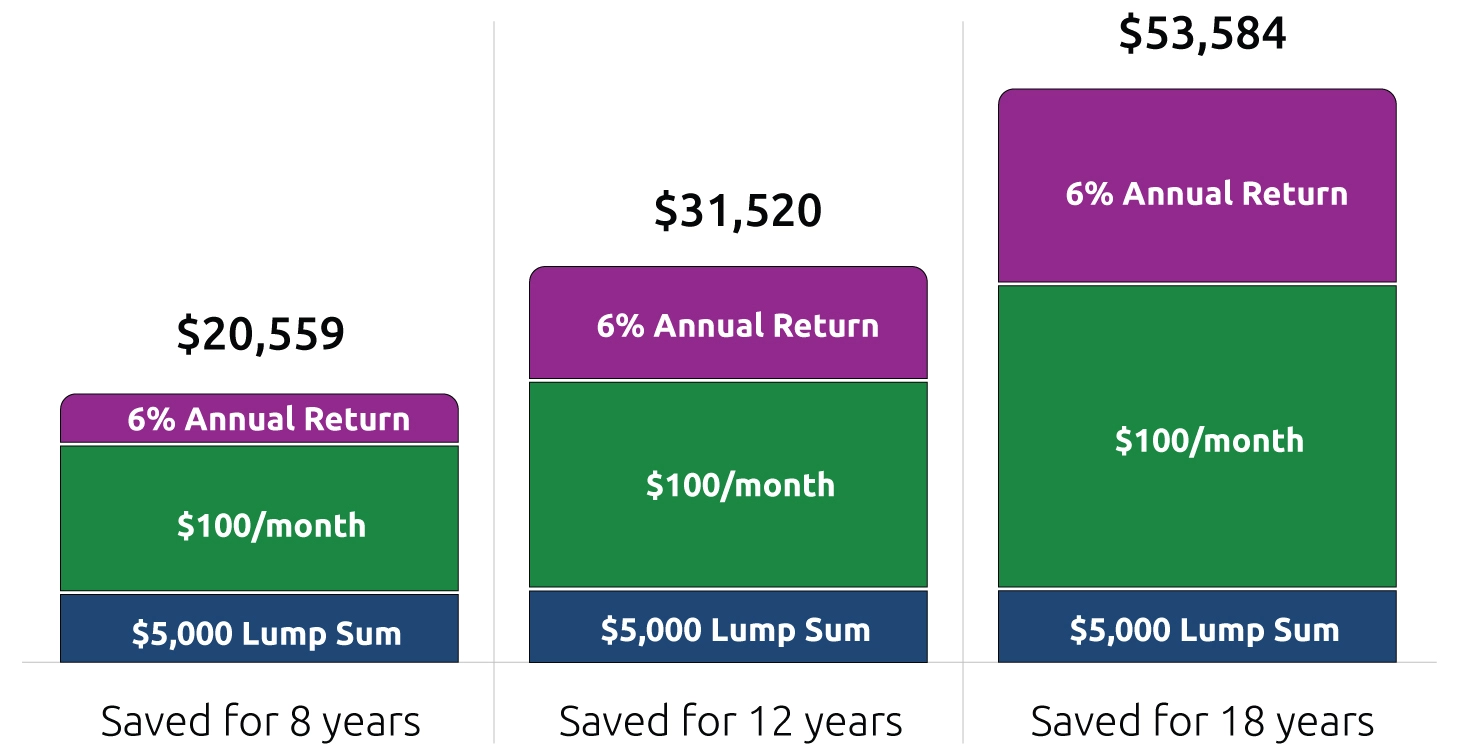Get to know WA529 Invest
How Our 529 Plan Works
No matter your child’s age, the best time to open a WA529 Invest account is today. The sooner you start, the more time you have to take advantage of compound earnings and unique tax benefits.
Start early to make the most of your savings
Saving early has the potential to deliver compounding earnings over a longer period of time.
 529 fact
529 fact
You don’t have to save alone. Friends and family can gift contributions to help grow your savings using Ugift®.
Advantages of starting early
See how your savings might have grown if you started with $5,000 and continued to save $100 a month for 8, 12 and 18 years.
- Earnings
- Subsequent Contributions
- Initial Contribution

Save for 8 years
- Earnings:
- 6% Annual Return
- Subsequent Contributions:
- $100 per month
- Initial Contribution:
- $5,000 Lump Sum
- Total savings growth over time:
- $20,559
Save for 12 years
- Earnings:
- 6% Annual Return
- Subsequent Contributions:
- $100 per month
- Initial Contribution:
- $5,000 Lump Sum
- Total savings growth over time:
- $31,520
Save for 18 years
- Earnings:
- 6% Annual Return
- Subsequent Contributions:
- $100 per month
- Initial Contribution:
- $5,000 Lump Sum
- Total savings growth over time:
- $53,584
Graph Footnotes
- This chart assumes a $5,000 lump-sum investment, a $100 monthly investment and 6% annual rate of return. The calculations are for illustrative purposes only, and the results are not indicative of the performance of any investments. The calculations do not reflect any plan fees or charges that may apply. If such fees or charges were taken into account, returns would have been lower. With any long-term investment, investment return may vary. Such automatic investment plans do not assure a profit or protect against losses in declining markets. Account value in the investment portfolios is not guaranteed and will fluctuate with market conditions.
How much should you save toward your child’s tuition?
Get a quick estimate of approximately how much you’ll need to save to meet your savings goals using our calculator tool.
Estimate your savings
Unique tax benefits
As a 529 Plan, WA529 Invest provides families compelling income tax benefits. Although contributions are not deductible on your federal tax return, any investment earnings can grow tax-deferred.
- Tax-deferred growth
Any earnings can grow 100% tax-deferred - Tax-free withdrawals
When used for qualified higher educational purposes1
See the WA529 Invest Program Details Booklet for more details.
Who’s Eligible?
You, your friends, family, neighbors and more… almost anyone over the age of 18 can open or contribute to WA529 Invest.
Here are the details.
Account owners
- At least 18 years old with a valid Social Security Number (SSN) or Individual Taxpayer Identification Number (ITIN) with a valid permanent U.S. residential address
- Person opening the account is the account owner and can designate a successor account owner in the event of their death
- Certain trusts, estates and corporations can also open an account with a valid taxpayer ID number*
Account Owner Footnote
- *Additional restrictions may apply; please refer to the Program Details Booklet for details.↩
Beneficiaries
- The beneficiary is the future student and only needs a valid Social Security Number (SSN) or Individual Taxpayer Identification Number (ITIN)
- It can be your child, grandchild, even you—and you don’t need to be related to the beneficiary
- Only one beneficiary to an account, except when an entity creates a general scholarship account
An account can be opened by anyone (like a parent, grandparent or family friend), and the account ownership can be transferred to another eligible student or entity by submitting the appropriate plan form.

Qualifying expenses
With WA529 Invest, you have full control over how to use your funds. Here is the wide variety of qualified education expenses that can support your child in any path they choose to take:
- Tuition at any eligible private or public college or university, community college, technical college, graduate school and professional school across the U.S. and many abroad
- Certain room and board (housing and food) related expenses
- Fees, books, supplies and other equipment needed for enrollment and attendance
- Computers and related technology such as internet access fees, software or printers
- Certain additional enrollment and attendance costs for beneficiaries with special needs
- Pay for K-12 qualified expenses - up to $10,000 annually can be used per student at a public, private or religious elementary, middle or high school (the limit will increase to $20,000 beginning January 1, 2026). Click here for more information on recent changes to qualified expenses3
- Pay for apprenticeship expenses tax-free—apprenticeship programs must be registered and certified with the Secretary of Labor under the National Apprenticeship Act3
- Pay for qualified expenses when enrolled in a recognized postsecondary credentialing program. Click here for more information on recent changes to qualified expenses
Funds can also be used in three other helpful ways:
- Repay student loans—up to a $10,000 lifetime limit per individual tax-free (including principal and interest on any qualified education loan)3
- Transfer additional or leftover funds to yourself or another member of the family such as a brother or sister, up to the first cousin
- WA529 Invest funds may be rolled over to a Roth IRA in the name of the beneficiary. Funds rolled over to a Roth IRA can be withdrawn free from income tax. There are conditions that must be met, including the 529 plan must have been in existence for at least 15 years. You should talk to a qualified professional about how tax provisions affect your circumstances.
See plan details for additional information
Have more questions?
No. Your WA529 Invest funds can be used at any eligible university in the country—and even some abroad. This includes public and private colleges and universities, apprenticeships, community colleges, graduate schools and professional schools.1 Up to $10,000 annually can be used toward K-12 qualified expenses (the limit will increase to $20,000 beginning January 1, 2026).1 In addition, your 529 can be used for student loan repayment up a $10,000 lifetime limit per individual.1 Review a list of qualifying expenses and the state tax treatment of withdrawals for these expenses in the Program Details Booklet.
Footnotes
- 1Withdrawals for qualified expenses at K-12 public, private, or religious schools, registered apprenticeship programs, recognized postsecondary credentialing programs, and student loan repayment can be withdrawn free from federal income tax. State tax treatment varies. You should talk to a qualified professional about how tax provisions affect your circumstances.↩
If your child ends up not needing the funds for college, you always have multiple options for your money:
- Your funds can be used to pay for a variety of eligible education expenses, including public or private colleges, universities, community colleges, professional and vocational schools, certain apprenticeship expenses or postgraduate programs in the United States—and even some schools abroad.1
- Your 529 can be used for student loan repayment up to a $10,000 lifetime limit per individual.1
- Pay for K-12 qualified expenses - up to $10,000 annually can be used per student at a public, private, or religious elementary, middle, or high school (the limit will increase to $20,000 beginning January 1, 2026). Qualified education expenses include curriculum, instructional materials, tutoring by approved professionals, standardized test and dual enrollment fees, and licensed educational therapies for students with disabilities. Click here for more information on recent changes to qualified expenses.1
- You can transfer the funds to another eligible beneficiary, such as another child, a grandchild or yourself.
- If you just want the money back, you can withdraw the funds at any time. If funds are withdrawn for a purpose other than qualified higher education expenses, the earnings portion of the withdrawal is subject to federal and applicable state taxes plus a 10% additional federal tax on earnings (known as the “Federal Penalty Tax”). See the Program Details Booklet for more information and exceptions.
- Roll over funds to a Roth IRA. Limitations apply.2
- Pay for qualified expenses when enrolled in a recognized postsecondary credentialing program. Click here for more information on recent changes to qualified expenses.
- Or you can always wait because the funds never expire, and often the choice to go to school is a delayed decision. So if your child changes their mind down the road, your savings will still be available.
Footnotes
- 1Withdrawals for qualified expenses at K-12 public, private, or religious schools, registered apprenticeship programs, recognized postsecondary credentialing programs, and student loan repayment can be withdrawn free from federal income tax. State tax treatment varies. You should talk to a qualified professional about how tax provisions affect your circumstances.↩
- 2Rollovers are permitted from an account to a Roth IRA without incurring federal tax penalties. State tax treatment of a rollover from a 529 plan into a Roth IRA is determined by the state where you file state income tax. There are conditions that must be met, including the 529 plan must have been in existence for at least 15 years.
You should talk to a qualified professional about how tax provisions affect your circumstances.↩
Your WA529 Invest account can be used at eligible colleges, universities, vocational schools, community colleges, graduate or postgraduate programs, apprenticeships, credentialing programs and more.1 Contact your school to determine whether it qualifies as an eligible educational institution or use the Federal School Code Search tool on the Free Application for Federal Student Aid (FAFSA) website.
Footnotes
- 1Withdrawals for qualified expenses at K-12 public, private, or religious schools, registered apprenticeship programs, recognized postsecondary credentialing programs, and student loan repayment can be withdrawn free from federal income tax. State tax treatment varies. You should talk to a qualified professional about how tax provisions affect your circumstances.↩
There are no sales charges, startup fees or maintenance fees associated with WA529 Invest account. For details on total annual asset-based fees, comprised of the underlying investment expenses for each investment portfolio and the plan manager fee, review the Plan Fee Table in the Program Details Booklet.
